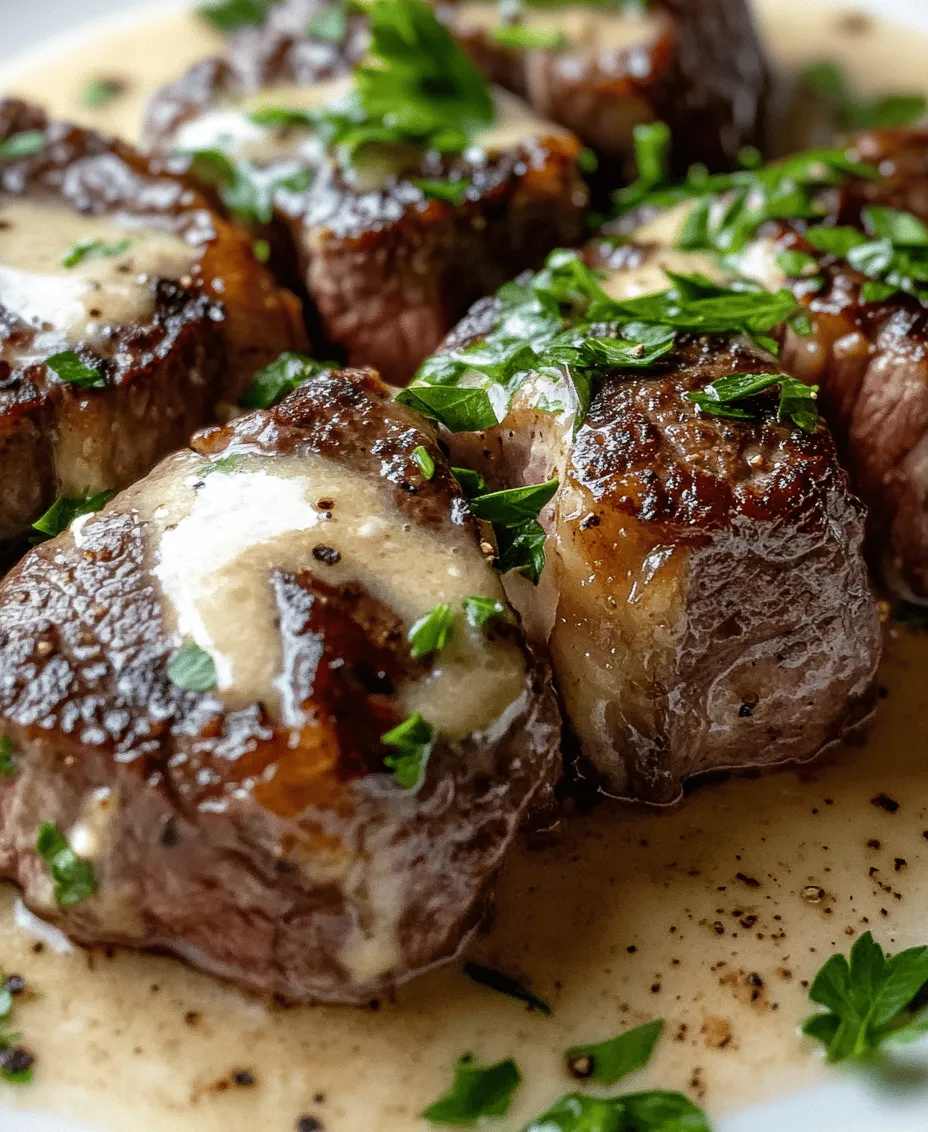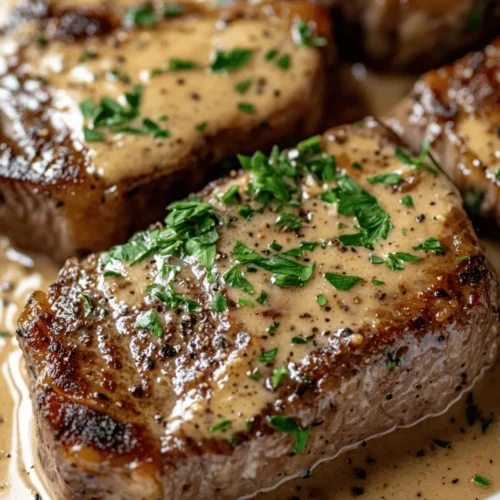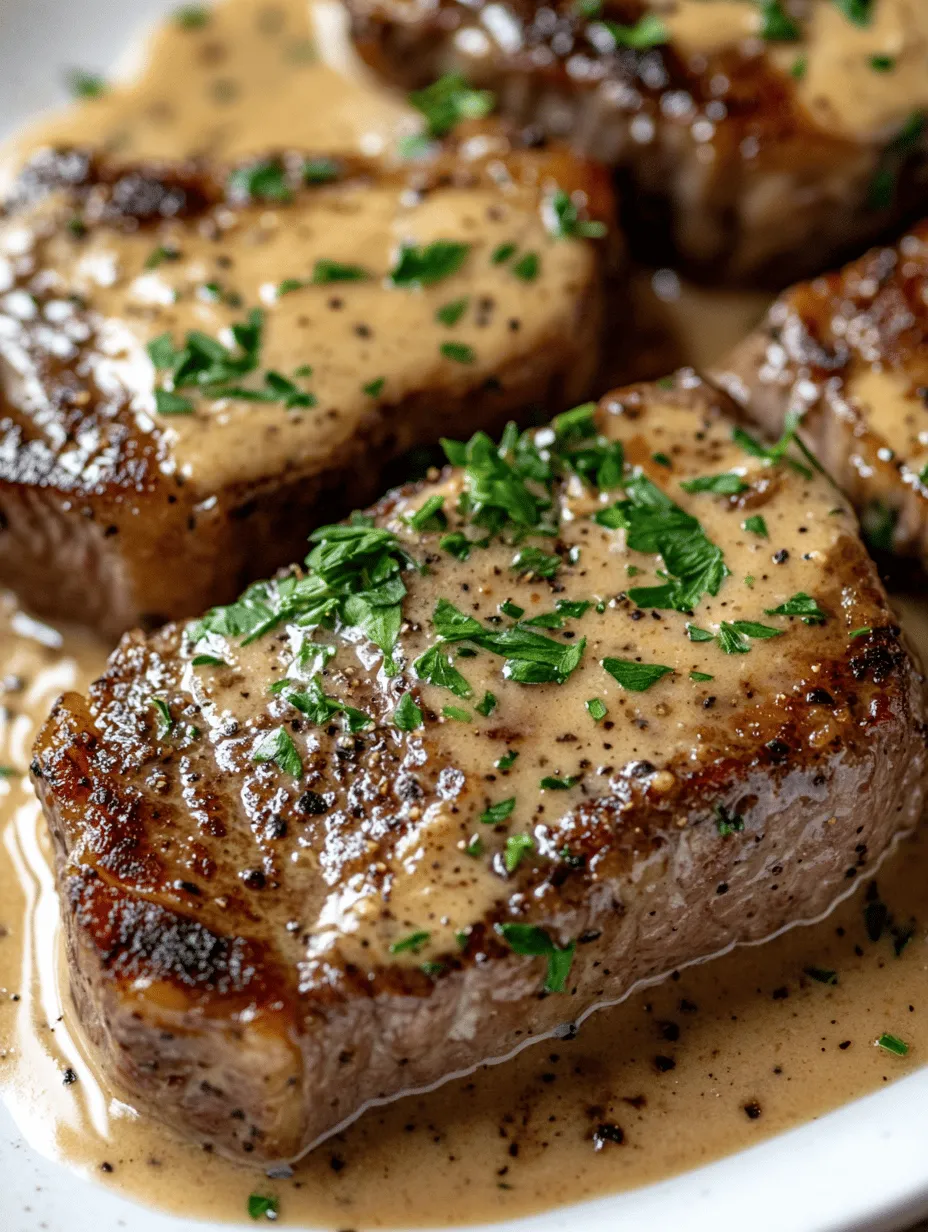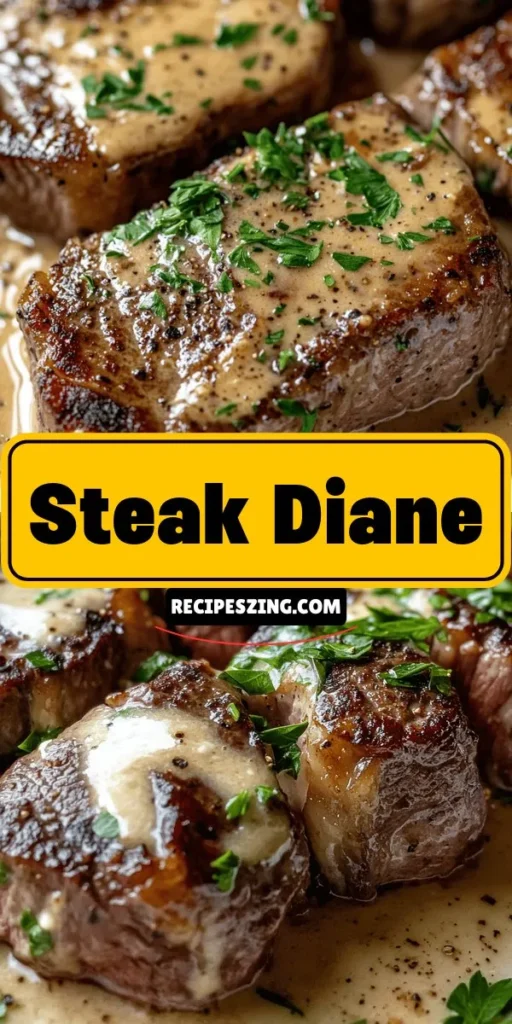Introduction
Steak Diane is a timeless classic that has graced the tables of gourmet restaurants and home kitchens alike. This elegant dish, known for its rich flavors and impressive presentation, brings a touch of sophistication to any meal. The joy of preparing gourmet recipes at home cannot be understated; it allows you to create memorable dining experiences for family and friends while honing your culinary skills. Today, we will delve into the delightful world of Steak Diane with a modern twist that enhances its traditional charm. The Steak Diane Delight recipe showcases a perfect blend of savory and aromatic ingredients, offering a flavor profile that’s both luxurious and comforting.
Understanding Steak Diane
The History and Origins of Steak Diane
Steak Diane has its roots in the mid-20th century, attributed to both American and European culinary traditions. The dish is believed to have been born in the 1940s in the United States, where it was popularized by upscale restaurants as a theatrical presentation cooked tableside. The name “Diane” is thought to reference the Roman goddess of the hunt, reflecting the dish’s emphasis on high-quality beef. With its dramatic flambé presentation and vibrant sauce, Steak Diane quickly became a symbol of fine dining.
Traditional Ingredients Typically Used in Steak Diane
At its core, Steak Diane consists of tender beef steaks, typically cut from the loin or fillet, which are cooked to perfection and served with a rich, creamy sauce. Traditional ingredients include shallots, garlic, brandy or cognac, Dijon mustard, heavy cream, and Worcestershire sauce. These components come together to create a sauce that is both savory and decadent, making each bite a delightful experience.
The Modern Twist on the Classic Recipe
While the classic Steak Diane remains beloved, modern interpretations of the dish have emerged, focusing on enhancing flavors and simplifying preparation. The Steak Diane Delight recipe incorporates fresh ingredients and techniques that elevate the dish while maintaining its essence. By using high-quality cuts of beef, experimenting with different aromatics, and balancing flavors with precision, we create a dish that is as enjoyable to prepare as it is to eat.
Importance of the Dish in Culinary Culture
Steak Diane holds a special place in culinary culture, symbolizing the elegance of home cooking paired with fine dining. It encourages cooks to embrace the art of gastronomy and to take pride in crafting a meal that is both beautiful and delicious. The dish invites creativity and personalization, allowing chefs to adapt the recipe to their tastes while honoring its classic roots. Steak Diane serves not only as a meal but as a celebration of culinary tradition and innovation.
Ingredients Breakdown
To create the perfect Steak Diane Delight, we must pay careful attention to each ingredient that contributes to its exquisite flavor. Below is a detailed description of the essential components of this recipe.
Boneless Beef Steaks
The foundation of any great Steak Diane is, of course, the beef. Choosing the right cut of meat is crucial; boneless beef steaks such as filet mignon or sirloin are ideal for their tenderness and flavor. Quality is paramount—opt for grass-fed or organic beef whenever possible. A well-marbled steak will not only enhance the richness of the dish but also ensure a juicy, satisfying bite.
Olive Oil
Olive oil plays a crucial role in the cooking process, helping to sear the beef and create a flavorful crust. Using high-quality extra virgin olive oil can add a layer of complexity to the dish. It also contributes healthy fats that enhance the overall richness of the sauce.
Salt and Pepper
Seasoning is fundamental in cooking, and salt and pepper are the cornerstones of flavor enhancement. A generous pinch of salt brings out the natural flavors of the beef, while freshly cracked black pepper adds warmth and a slight kick. Be sure to season both sides of the steak before cooking for an even flavor profile.
Unsalted Butter
Unsalted butter is essential for creating a rich, velvety sauce. It not only adds creaminess but also enhances the flavors of the other ingredients. Using unsalted butter allows you to control the overall saltiness of the dish, ensuring a harmonious balance.
Shallots and Garlic
Shallots and garlic serve as the aromatic foundation for the sauce. Shallots have a milder, slightly sweet flavor compared to onions, making them a perfect choice for this recipe. Garlic, with its robust and pungent notes, complements the shallots beautifully. Together, they create a fragrant base that elevates the richness of the beef and the sauce.
Brandy or Cognac
One of the most striking aspects of Steak Diane is the flambé technique, which involves igniting brandy or cognac to add depth to the sauce. This step not only intensifies the flavors but also creates a beautiful presentation as the flames dance during cooking. The alcohol burns off, leaving behind a rich, complex flavor that enhances the overall dish.
Dijon Mustard
Dijon mustard is a key ingredient that balances the richness of the sauce with its tangy and slightly spicy notes. It adds a layer of complexity that cuts through the creaminess, ensuring that each bite is well-rounded and flavorful. A tablespoon or two of Dijon mustard is all you need to elevate the sauce to new heights.
Heavy Cream
Heavy cream is essential for achieving the luxurious texture of the sauce. It adds a silky smoothness that coats the beef perfectly, making each bite indulgent. The cream also mellows the flavors, bringing all the components together in a harmonious blend.
Worcestershire Sauce
Worcestershire sauce is a secret weapon in many savory dishes, and Steak Diane is no exception. Its umami-rich profile enhances the overall flavor of the sauce, adding depth and complexity. Just a splash goes a long way in elevating the dish.
Fresh Parsley
Fresh parsley not only adds a pop of color to the finished dish but also contributes a fresh, herbaceous note that brightens the flavors. A sprinkle of chopped parsley just before serving brings a touch of vibrancy and visual appeal, making the dish as beautiful as it is delicious.
Preparation Steps Explained
Now that we have a clear understanding of the ingredients, it’s time to dive into the preparation steps for our Steak Diane Delight. Follow these detailed instructions to ensure your dish turns out perfectly.
1. Choosing and Preparing Your Steak: Start by selecting high-quality boneless beef steaks. Pat them dry with paper towels to remove excess moisture, which will help achieve a nice sear. Season both sides generously with salt and freshly cracked black pepper.
2. Searing the Steak: In a large skillet, heat a tablespoon of olive oil over medium-high heat. Once the oil is hot and shimmering, carefully place the seasoned steaks in the skillet. Sear for about 3-4 minutes on each side, depending on your desired level of doneness. For medium-rare, aim for an internal temperature of 130°F (54°C). Once cooked to your liking, transfer the steaks to a plate and cover them loosely with foil to keep warm.
3. Creating the Sauce: In the same skillet, reduce the heat to medium and add a tablespoon of unsalted butter. Once melted, add finely chopped shallots and minced garlic. Sauté for about 2-3 minutes until the shallots are translucent and fragrant, stirring frequently to prevent browning.
4. Flambéing with Brandy: Carefully add ¼ cup of brandy or cognac to the skillet. If you’re feeling adventurous, you can flambé the brandy by tipping the skillet slightly away from you and igniting the alcohol with a long lighter. Allow the flames to subside as the alcohol burns off, which should take about 30 seconds. This step is not only dramatic but also infuses the sauce with deep, rich flavors.
5. Building the Sauce: After the flambé, stir in a tablespoon of Dijon mustard, ½ cup of heavy cream, and a splash of Worcestershire sauce. Whisk the ingredients together, allowing the sauce to simmer gently for a few minutes until it thickens slightly. Taste and adjust seasoning with additional salt and pepper as needed.
6. Finishing Touches: Once the sauce has reached your desired consistency, return the steaks to the skillet, spooning the sauce over them to coat. Allow the steaks to warm through for a minute or two.
7. Serving: Transfer the steaks to serving plates, drizzle with the remaining sauce, and garnish with freshly chopped parsley. Serve immediately with your choice of sides, such as garlic mashed potatoes, asparagus, or a fresh green salad.
With these steps, you are well on your way to impressing your dinner guests or enjoying a sumptuous meal at home. The Steak Diane Delight recipe is a perfect blend of tradition and modern flair, elevating a classic dish to new heights of flavor and sophistication. As you embark on this culinary journey, remember to savor not only the meal but also the joy of creating something truly special in your kitchen.

Preparing the Steaks: Importance of Seasoning and Resting
To create the perfect Steak Diane Delight, the first step lies in preparing the steaks themselves. The importance of seasoning cannot be overstated. A well-seasoned steak enhances the natural flavors of the meat, and it’s essential to use a generous amount of kosher salt and freshly ground black pepper. Season both sides of the steak at least 30 minutes before cooking; this allows the salt to penetrate the meat, creating a more robust flavor profile.
Equally important is the resting period after cooking. Once the steaks are cooked to your desired doneness, remove them from the heat and let them rest for about 5-10 minutes. This resting period allows the juices to redistribute throughout the meat, resulting in a more tender and flavorful steak. Skipping this step often leads to juices running out when the steak is sliced, leaving you with a drier piece of meat.
Cooking Techniques for Perfect Steaks: Searing Tips and Doneness Levels
Achieving the perfect steak is an art that involves precise cooking techniques. Start by preheating a cast-iron skillet or heavy-bottomed pan over medium-high heat until it’s hot. The key to a great sear is high heat; this creates a caramelized crust that enhances the flavor and texture of the steak.
Searing Tips:
– Oil: Use a high smoke point oil like canola or grapeseed oil to prevent burning.
– Don’t overcrowd: Cook one or two steaks at a time to maintain the heat in the pan. Overcrowding lowers the temperature, preventing a proper sear.
– Press down: As the steak cooks, gently press down with a spatula to ensure even contact with the pan.
Doneness Levels:
Understanding steak doneness is essential for cooking to perfection:
– Rare: 120-125°F – Cool red center.
– Medium Rare: 130-135°F – Warm red center (ideal for Steak Diane).
– Medium: 140-145°F – Warm pink center.
– Medium Well: 150-155°F – Slightly pink center.
– Well Done: 160°F and above – Little to no pink.
Use an instant-read thermometer for accuracy. For the best results, aim for medium-rare, as it retains the most juiciness and flavor.
Sauce Preparation: Step-by-Step Process for Creating the Flavorful Sauce
The sauce is what truly elevates Steak Diane Delight. Made from a few simple ingredients, it brings a rich depth of flavor to the dish.
1. Gather Ingredients: You will need butter, Dijon mustard, Worcestershire sauce, beef broth, and a splash of cream.
2. Deglaze the Pan: After cooking the steaks, reduce the heat to medium and add a tablespoon of butter to the pan. Once melted, pour in a splash of beef broth, scraping up any brown bits stuck to the bottom. These bits are packed with flavor.
3. Add Mustard and Worcestershire: Stir in a tablespoon of Dijon mustard and a teaspoon of Worcestershire sauce, mixing well. This combination provides a tangy, savory base for your sauce.
4. Incorporate Cream: Finally, add a splash of heavy cream to create a luscious texture. Stir continuously until the sauce is heated through and slightly thickened.
Sautéing Shallots and Garlic: Achieving the Perfect Aroma
Shallots and garlic are essential aromatics that add depth to the sauce. Start by finely chopping one medium shallot and a couple of garlic cloves.
1. Sautéing: In the same pan used for the steak, add an additional tablespoon of butter over medium heat. Once melted, add the shallots and garlic, cooking until they become translucent and fragrant, about 2-3 minutes.
2. Add to Sauce: Once sautéed, incorporate them into your sauce mixture. The aroma that fills your kitchen will be irresistible.
Flambéing: Safety Precautions and Flavor Enhancement
Flambéing adds a dramatic flair to your dish while enhancing the flavor profile. However, it’s essential to take safety precautions:
1. Choose the Right Alcohol: Use a high-proof brandy or cognac for flambéing. Avoid highly flammable spirit such as absinthe.
2. Remove from Heat: Before igniting, remove the pan from the heat source to prevent accidental flare-ups.
3. Ignite Carefully: Use a long lighter to ignite the alcohol. Stand back as the flames flare up, and allow them to subside naturally. The alcohol burns off, leaving behind a rich flavor.
Combining Ingredients: Achieving the Right Consistency and Flavor Balance
After flambéing, return the pan to low heat. Combine the sautéed shallots, garlic, and the deglazed sauce mix until everything is well incorporated.
1. Adjust Consistency: If the sauce is too thick, add a little more beef broth. If it’s too thin, let it simmer for a few more minutes until it reduces to your desired thickness.
2. Taste Test: Always taste and adjust seasoning as needed. A final sprinkle of salt and pepper can make a world of difference.
Serving Suggestions
Steak Diane Delight can shine on its own, but pairing it with the right sides can elevate your meal to a gourmet experience.
Ideal Sides to Pair with Steak Diane Delight
– Classic Pairings:
– Mashed Potatoes: Creamy mashed potatoes help soak up the delicious sauce.
– Sautéed Green Beans: Fresh, bright green beans add a crunchy contrast.
– Alternative Side Options:
– Roasted Vegetables: Seasonal roasted vegetables bring color and flavor.
– Rice Pilaf: A fluffy rice pilaf infused with herbs complements the richness of the steak.
– Salads: A light, crisp salad with a vinaigrette can refresh the palate.
Presentation Ideas for a Gourmet Dining Experience
– Plate with Style: Use a large plate, placing the steak at the center and drizzling the sauce artfully around it.
– Garnish: Fresh herbs like parsley or chives add a pop of color. A sprinkle of coarse sea salt can enhance the visual appeal and flavor.
Nutritional Information
Understanding the nutritional content of your meal is essential, especially if you are health-conscious. A typical serving of Steak Diane Delight contains:
– Calories: Approximately 450-600 calories (depending on the portion size and sides).
– Proteins: Rich in protein, with around 30-40 grams per serving.
– Fats: Contains healthy fats from the butter and cream, providing richness.
Balancing Indulgence with Healthy Eating Practices
While Steak Diane is indulgent, you can balance it with health-conscious decisions, like pairing it with a salad instead of heavier sides.
Portion Control and Serving Suggestions for Health-Conscious Diners
Consider serving smaller portions of steak alongside generous servings of vegetables or a salad. This way, you enjoy the richness of the dish without overindulging.
Culinary Techniques and Tips
Mastering the techniques used in Steak Diane Delight can enhance your culinary skills:
Essential Cooking Techniques Used in the Recipe
– Searing: Achieving a perfect crust on the steak.
– Sautéing: Properly cooking aromatics to build flavor.
– Deglazing: Using the pan drippings to create a sauce.
Common Mistakes to Avoid When Preparing Steak Diane
– Underseasoning: Failing to season adequately can result in bland steak.
– Overcooking: Use a thermometer to avoid overcooking; this can ruin the tenderness of the steak.
– Skipping the Resting Period: Don’t cut into the steak immediately after cooking.
How to Adjust the Recipe for Different Dietary Preferences
– Alternative Proteins: For a lighter option, consider using chicken or turkey tenderloins in place of steak.
– Vegan Version: Use portobello mushrooms or tofu as a steak substitute, and create a similar sauce using vegetable broth and plant-based cream.
Conclusion
Cooking Steak Diane Delight at home can be a rewarding experience that fills your kitchen with delightful aromas and flavors. This classic dish is not only a testament to culinary skills but also a way to connect with tradition while creating something truly special.
I encourage you to explore the world of traditional recipes, experimenting with ingredients and techniques to make them your own. The satisfaction of serving a delicious, homemade meal, especially one as elegant as Steak Diane, is unparalleled. Embrace the joy of cooking, and let every meal be an opportunity to create lasting memories with family and friends.



